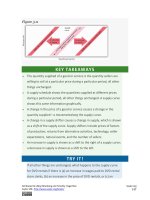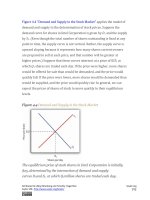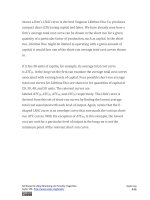Authors libby rittenberg 193
Bạn đang xem bản rút gọn của tài liệu. Xem và tải ngay bản đầy đủ của tài liệu tại đây (291.23 KB, 1 trang )
The intersection of the demand and supply curves for shares of stock in a
particular company determines the equilibrium price for a share of stock.
But what determines the demand and supply for shares of a company’s
stock?
The owner of a share of a company’s stock owns a share of the company,
and, hence, a share of its profits; typically, a corporation will retain and
reinvest some of its profits to increase its future profitability. The profits
kept by a company are called retained earnings. Profits distributed to
shareholders are called dividends. Because a share of stock gives its owner
a claim on part of a company’s future profits, it follows that the expected
level of future profits plays a role in determining the value of its stock.
Of course, those future profits cannot be known with certainty; investors
can only predict what they might be, based on information about future
demand for the company’s products, future costs of production,
information about the soundness of a company’s management, and so on.
Stock prices in the real world thus reflect estimates of a company’s profits
projected into the future.
The downward slope of the demand curve suggests that at lower prices for
the stock, more people calculate that the firm’s future earnings will justify
the stock’s purchase. The upward slope of the supply curve tells us that as
the price of the stock rises, more people conclude that the firm’s future
earnings do not justify holding the stock and therefore offer to sell it. At the
equilibrium price, the number of shares supplied by people who think
holding the stock no longer makes sense just balances the number of
shares demanded by people who think it does.
Attributed to Libby Rittenberg and Timothy Tregarthen
Saylor URL: />
Saylor.org
193









